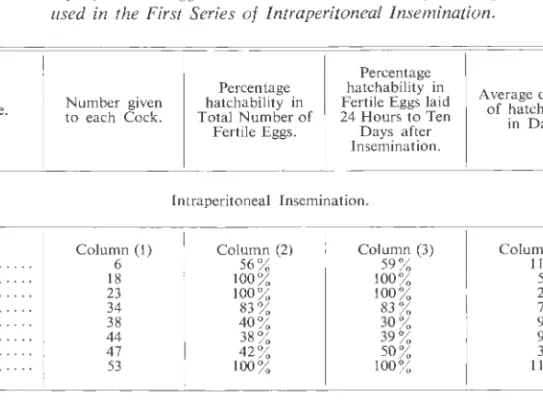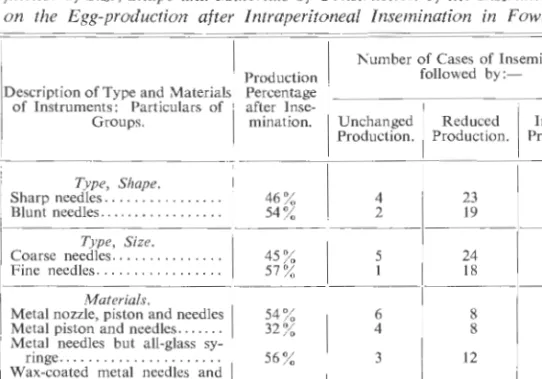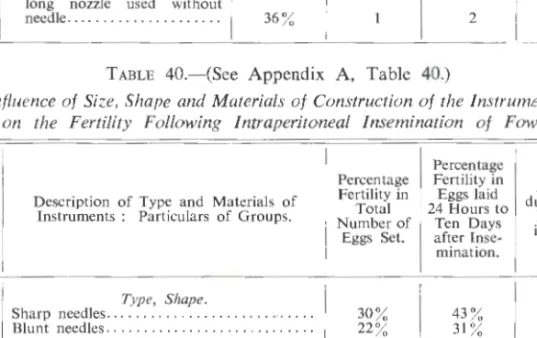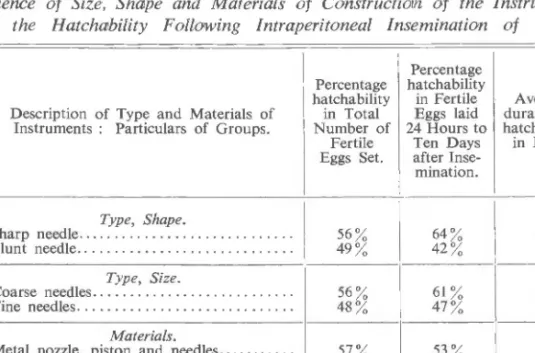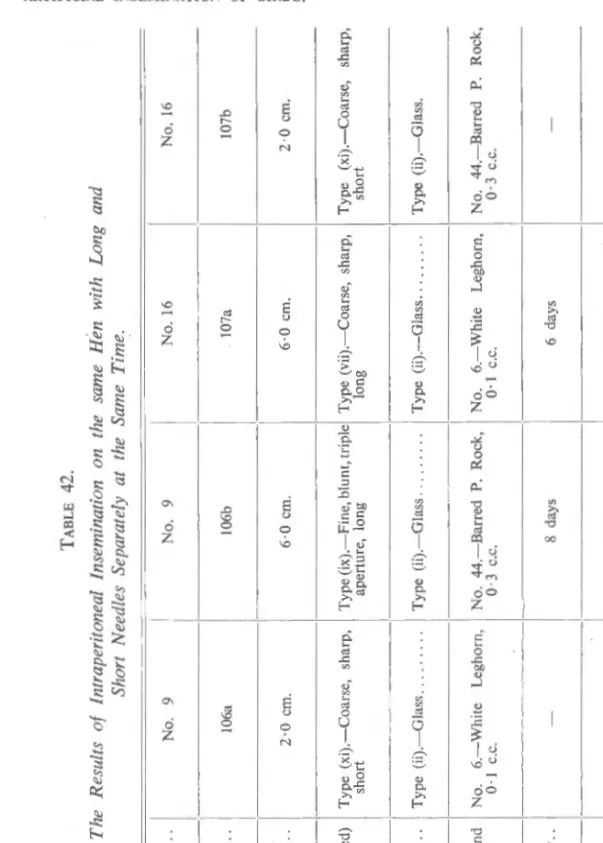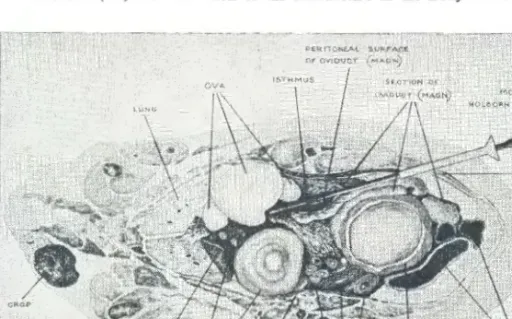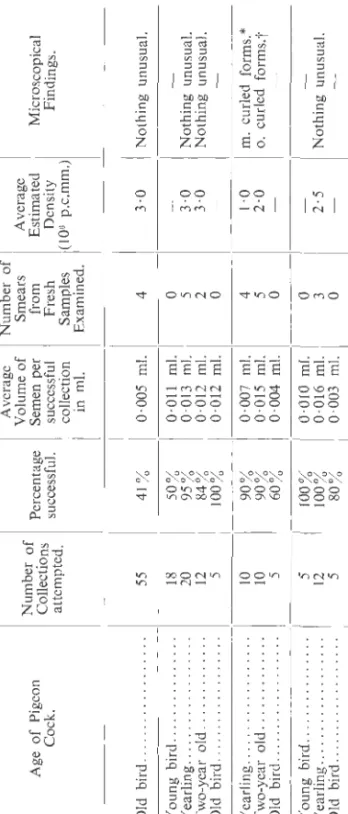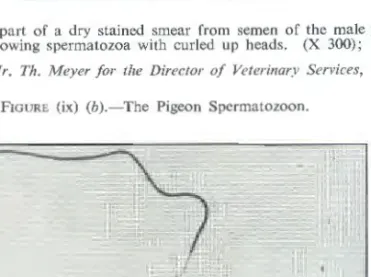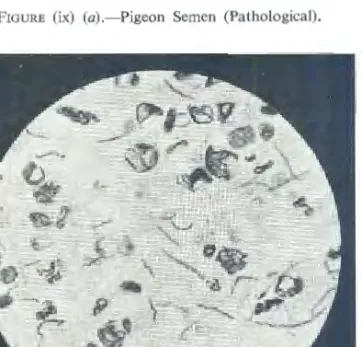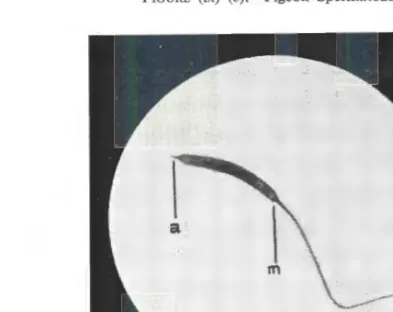Result.—The end of the glass capillary tube was found among the follicles in contact with the numerous smaller follicles. we). Photograph showing the position of the needle and inseminator mounted on an all-glass insulin syringe. Photograph showing the position of the instruments in the hen's body at the time of insemination by the intraperitoneal method (van Drimmelen, 1945a).
In other cases carbon particles were found in the region of the ovary. The dose of sperm given in intraperitoneal insemination surgery and the dilution of sperm used will be referred to in section (9). Direction of penetration and position achieved by openings of various instruments used for intraperitoneal insemination.
Records were kept of the volume [see part (1)], estimated density and morphology of some, and these data are shown in Table 44 [see figure (ix)]. Photomicrograph of acrosome (a) and center piece (m) of some pigeon sperm cells, showing the very small size of the center piece in the pigeon. Fertilizing power of sperm. - The data on the fertilization qualities of the semen samples tested during the first series of inseminations are shown in Tables 46 to 48 (see also Appendix B).
Photomicrograph of the head portion of avian spermatozoa, showing the acrosome (a), the head proper (b), the midpiece (m), and a portion of the tail (c).
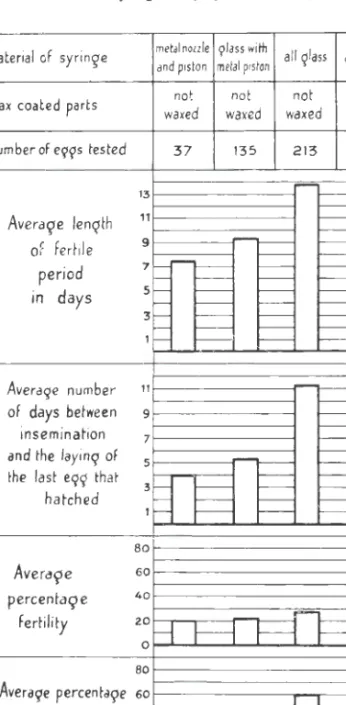
C. VAN DRIMMELEN
The hatchability of fertile eggs obtained with the sperm from different donors used in the first series of intraperitoneal collection. Dose of Semen.- The dose of semen was not varied markedly during the first series of inseminations, as experience showed [described in Part (2)] that the minimum fully effective dose established by Burrows and Quinn, viz. was also fully effective with intraperitoneal insemination. The diluent was mixed with the sperm by adding it to the sperm drop by drop while stirring all the time.
The Effect of Dilution of the Semen Used in the Results of Intraperitoneal Insemination in Hens. Discussion.- The examination of semen samples reported in part (9) was of a subsidiary nature, as working conditions prevented planned experiments in this area. Some of the results lend themselves to comparison with previously published reports in the literature, and some may form the basis for future work with semen from hens in South Africa.
The following results were achieved:-. i) The percentage of samples that were soiled and partially or totally unsuitable for examination or insemination varied between different males and averaged about one quarter when all untrained males were included. ii) The volume obtained per collection varied with different roosters at different times, but in no case did the mean exceed 0·75 c.c., which is less than the amount obtained by Burrows and Quinn iii). Semen viscosity also varied between different males and within the same male at different times. 44 A rolled head, protoplasmic drop, and irregular staining occurred in the case of the latter.
The variation between the results of different cocks was greater than between the results of different methods of insemination in the first series of inseminations. Crew (1926) noted that fecundity in the hen resulting from a single mating can be reduced both in the length of the fertile period and in the number of eggs fertilized by the effect of a subsequent coitus, i.e. the fresh spermatozoa replace the older sperm cells in fertilizing the eggs as they become available. The results of Parker, McKenzie and Kempster, (1942) who concluded that the fertilization of the ovum by different spermatozoa occurring simultaneously in the hen was largely a matter of chance, stimulated further work in this direction.
Summary of the results of all inseminations performed in the first and third series (doses of sperm given unmixed, separated or simultaneous in different. Quantity and by different methods.). Discussion.—The results of insemination with mixed sperm samples were inferior to those with pure sperm (Tables 57 and 58) and provided evidence to suggest that a mixed sperm sample tends to be reduced in quality to the poorer sperm components. her. that the poor quality of a given sperm sample can be compensated by mixing with better quality sperm. Insemination with separate sperm samples by different methods in one hen at the same time showed that-. a) the fertilizing quality of the sperm was more important than the route of introduction in determining which of the two types of sperm would gain the advantage in the competition for egg fertilization when present in the hen at the same time (Table 58);.
At the time of the first successful intraperitoneal insemination [experiment (4) part (2)] it was decided to plan investigations to determine the tissues and organs in which sperm were located during the fertile period in the poultry hen. The lack of information and the conflicting views held on this subject are mentioned in the literature review (chapter two) and in the preliminary articles (see Drimmelen; 1945 b and 1946 a).
